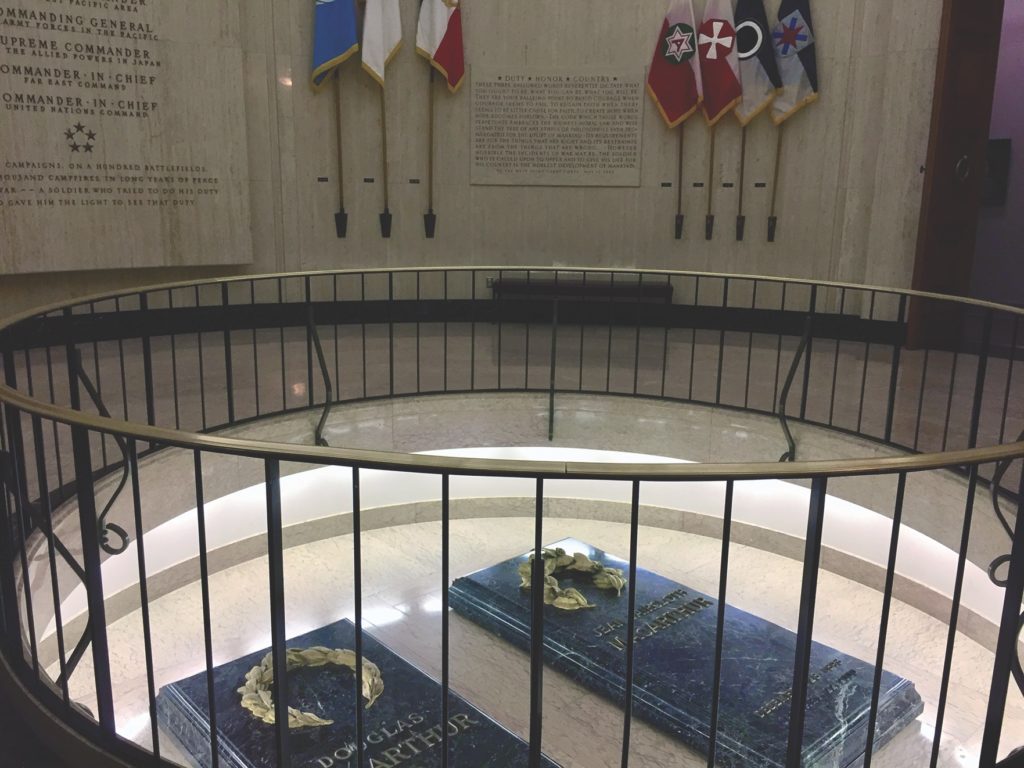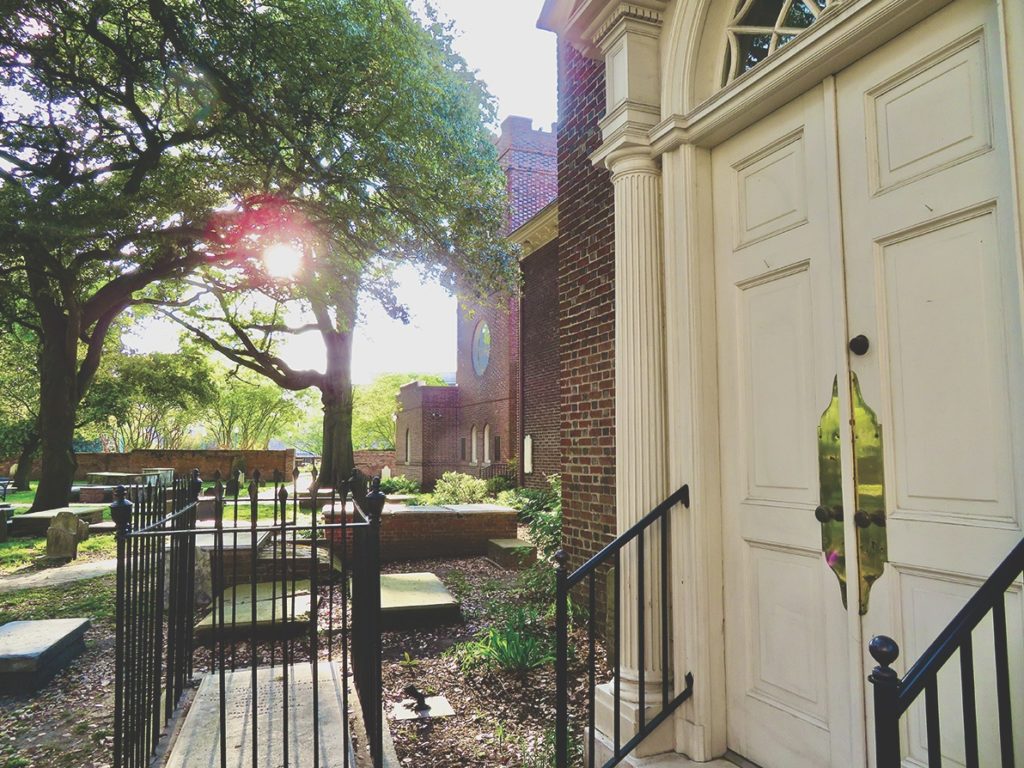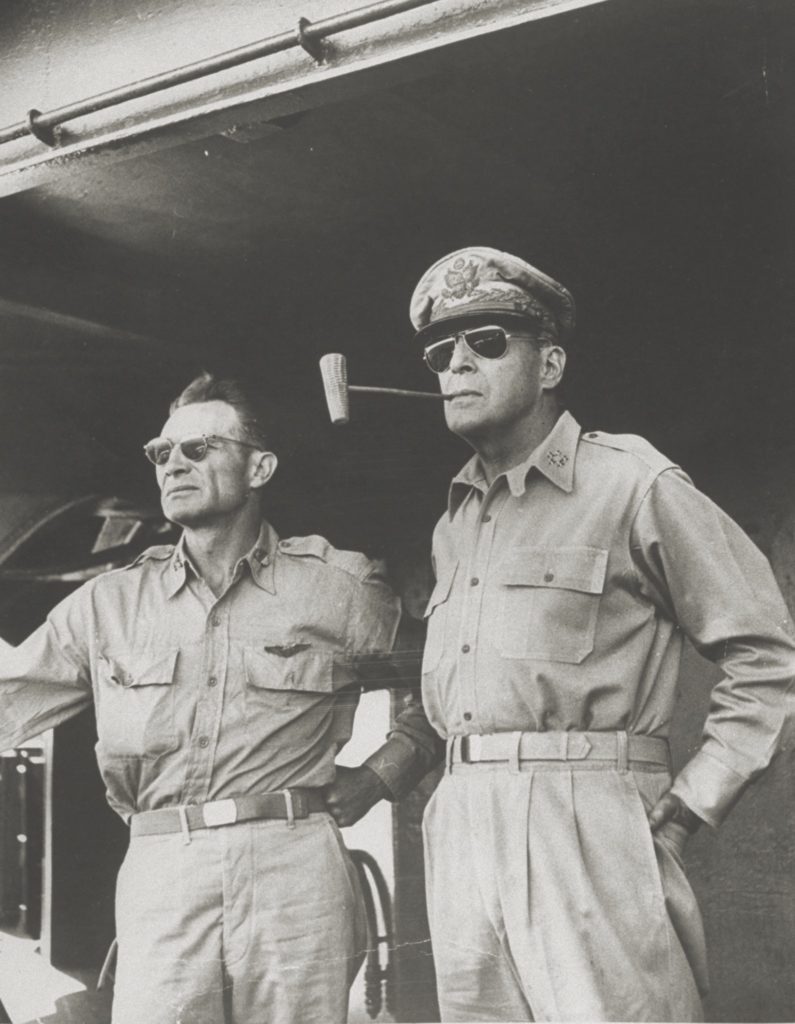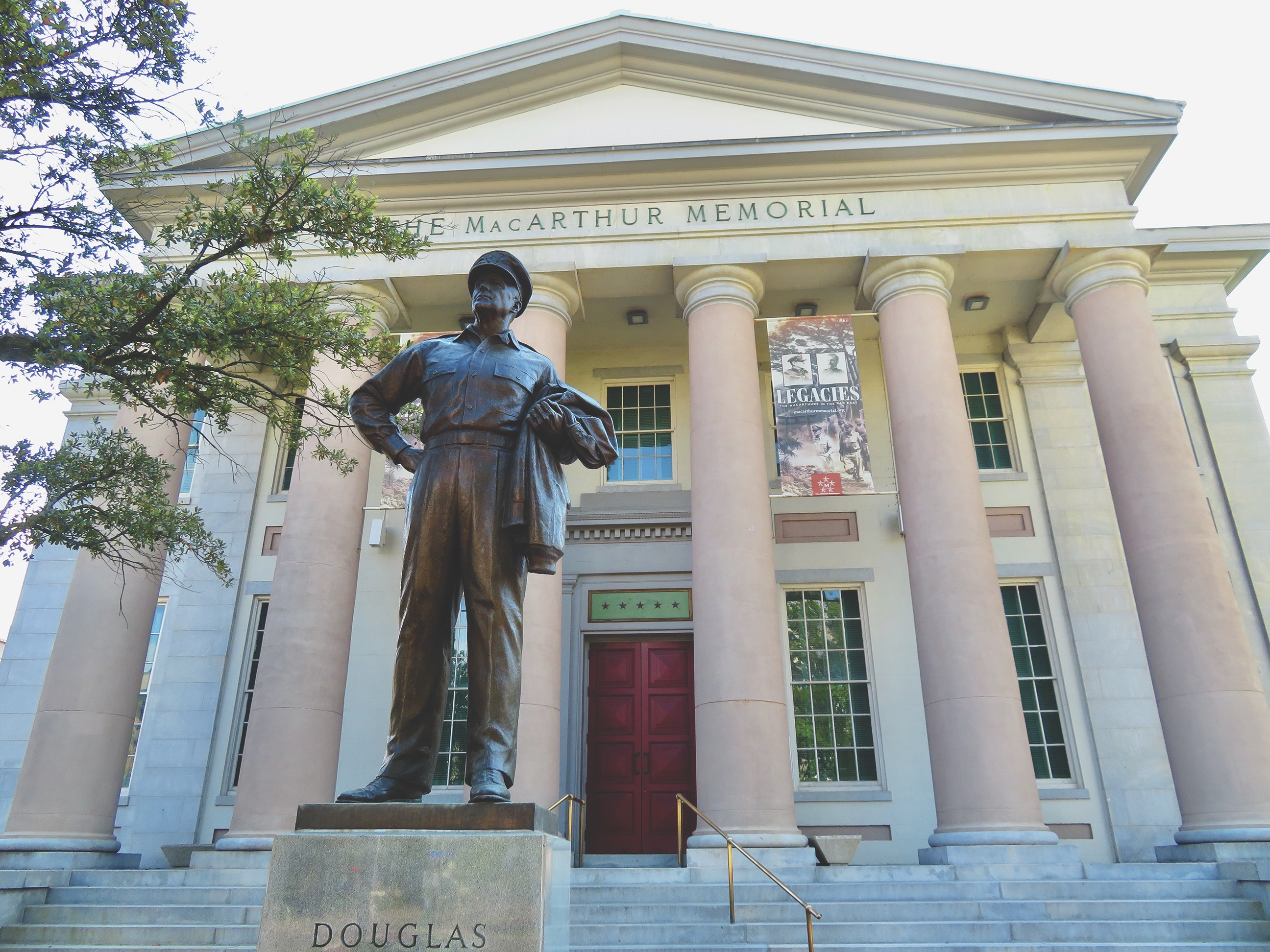Douglas MacArthur lived all over the world, but his family history brought him back to the Chesapeake.
I learned as a child that Douglas MacArthur was a hero. He had, after all, rescued my mother, Leanne Blinzler Noe (and her sister Ginny and father Lee and thousands of other Allied civilians), from Santo Tomas Internment Camp in Manila at the end of World War II. My mother wrote a letter of gratitude to the general in 1957, to which he responded briefly but sincerely on his official letterhead—and which she has gifted me.
On a recent trip to the MacArthur Memorial in Norfolk, Virginia, I tell the chief archivist, James Zobel, about that letter. “Wait a minute,” he says, clacking frantically on his computer. He dashes inside a mammoth vault of boxes containing millions of MacArthur-related documents and pulls one out. He lifts a pile of papers, and there, on top, my heartbeat quickening, I glimpse my mother’s schoolgirl-perfect penmanship.
“Dear General,” she had written on July 12, 1957, “Being such a modest man, you probably shy away from praise, but you certainly deserve the highest for your integrity, far-sightedness and keen sense of judgement.” She went on to say: “I was one of the prisoners in Santo Tomas, in Manila, who saw you when you and the First Cavalry arrived in February 1945. Looking back, it certainly was a close call, but we never lost faith in your promise ‘I Shall Return.’”
It’s no secret that MacArthur is a polarizing figure: a brilliant tactician, revered for helping to win World War II and overseeing the successful Allied occupation of postwar Japan, but also a man who could be vain, arrogant, suspicious, and insubordinate, to the point of getting fired by President Harry S. Truman in the middle of the Korean War for publicly disagreeing with him. I was curious if the city where he is buried shares my family’s reverence, as I would expect—a reason for my visit today.
“Not necessarily,” Zobel says. We are sitting in the memorial’s library, open to the public, with MacArthur’s 5,000 books surrounding us. “We’re trying to get to the truth of everything. That’s what he wanted. He’s always been controversial, but we embrace that, because there’s always two sides to every story.”
It strikes me that MacArthur lived all over the world, but never in Norfolk. Why is he here for eternity? “It’s because of his mother that this place is here,” Zobel says.
Mary Pinkney Hardy MacArthur grew up at Riveredge, a 20-room brick mansion in Norfolk’s Berkley neighborhood, across the Elizabeth River. There, on May 19, 1875, she married Arthur MacArthur, an army captain and Medal of Honor hero for the Union in the Civil War—two of her brothers refusing to attend because they had fought for Robert E. Lee’s Confederates.
The MacArthurs had two children in Norfolk, Arthur III and Malcolm, the latter of whom died at age four and is buried at Norfolk’s Cedar Grove Cemetery. Douglas was supposed to be born in Norfolk as well, but his mother ended up giving birth, on January 26, 1880, at Little Rock Barracks in Arkansas, where her husband had been stationed.
Riveredge is gone, but a small, rather obscure memorial park remains, with walls constructed from the original house’s bricks and lofty oaks that could easily date back to Mary’s time. When Douglas MacArthur visited Norfolk in 1951 to dedicate the park to his mother, he murmured that he felt Norfolk was his spiritual home. In 1960, town officials remembered that sentiment, lobby-ing MacArthur with the offer of an archive containing all of his belongings alongside his final resting place.
They targeted the grandiose old City Hall, built in 1850, as the memorial’s possible location, and MacArthur said, “‘Yeah, that looks pretty good,’” Zobel says. The city worked with MacArthur to design the interior, including its circular sunken crypt and two marble sarcophagi (for him and his wife, Jean), but he never got to see the finished project. He died on April 5, 1964—nearly 13 years after Truman fired him and just short of the planned Memorial Day dedication.


His funeral took place on April 11 at St. Paul’s, a historic brick church two blocks away. When I visit, I see time-worn tombstones scattered about the grounds, and my eyes grow wide as I read the dates, some reaching back to the 1700s. I catch sight of a small sign: “Cannonball,” and an arrow. A narrow, bush-edged path leads to a side wall of the church where, way up high, a cannonball remains embedded, shot from Loyalist Lord Dunmore’s fleet during the 1776 attack on the city. I imagine the stately, tree-shaded site swarming with MacArthur’s funeral attendees, including prime ministers, ambassadors, governors, and what army officials called the 20th century’s greatest assembly of military men. A procession lined the streets as the general took his final journey by caisson to the memorial.
Today, MacArthur lies beneath the memorial’s grand rotunda beside Jean, who died in 2000 (his mother is in Arlington National Cemetery, next to his father). Inscriptions and flags from the general’s military career decorate the walls, along with his long list of accomplishments—from 1903 West Point graduate to commander in chief, United Nations Command. The memorial’s museum portion awaits in the retrofitted hallways nearby, a chronological march through MacArthur’s life in nine galleries showcasing priceless military and personal artifacts in the broader context of 20th-century history.
As we walk through the displays, Zobel points out choice bits here and there—a chest of silverware, the only thing that survived from MacArthur’s Manila Hotel residence; his pistol, dug up on Corregidor years after his Philippine escape; General Hideki Tojo’s sword, taken just as he tried to kill himself. Here, too, are the general’s trademark hat, corncob pipe, and Ray-Ban sunglasses.

As Zobel indicated when we first met, the displays don’t hold back on their presentation of a complex man. He shows me, for example, MacArthur’s final evaluation report of Dwight D. Eisenhower upon his departure in 1937 as MacArthur’s chief of staff. Zobel notes, “He puts on here, ‘the most brilliant officer.’ They don’t get along personally, but he doesn’t quash his career. That’s the dichotomy.”
But there are more personal stories to uncover at the memorial. For example, his love letters—but not to his wife. “All his materials get destroyed in Manila,” Zobel says. “The only thing that keeps popping up are the letters he wrote all these girls throughout his life. One is a 28-page rhyming couplet poem to this girl about how ‘I’m going to die in this monster battle and you’re going to mourn me the rest of your life.’”
He points to another photo in the “World War II” gallery. “This one is very telling,” he says. “This is Emilio Aguinaldo, Manuel Quezon, and José Laurel, the first three presidents of the Philippines. These guys were his best friends. He was not a colonial who hung out with the White folks. Quezon was his son’s godfather. In the Spanish culture, that’s the bomb.”
MacArthur has been dead for 57 years, and the World War II and Korean War generations are aged or gone. I ask Zobel how relevant MacArthur is today.
“The entire situation in the Pacific is the same as it was when Truman fired him,” Zobel says as we study a map of the South China Sea in the gallery covering the Cold War’s beginnings. “MacArthur said: ‘You don’t deal with this now, you’re going to have everything two generations from now.’ And that’s the thing about MacArthur. Everything he has predicted [about the importance of Asia to America’s future] has come true,” among them China’s aggressive quest to expand power, the strong U.S.-Japanese alliance, and a divisive Korean Peninsula.
Zobel shares that members of the Joint Forces Staff College, National Defense University, and Joint Advanced War-fighting School have all come to the memorial’s research center to study MacArthur’s actions and Cold War history in relation to current-day events in the Asia-Pacific region. “MacArthur’s not this person who’s dead and gone,” Zobel says. “He remains relevant.” And Norfolk—and the MacArthur Memorial, with its archives and research center—remains at the center of it.
As I head out of Norfolk, past towering military ships reflecting off the harbor’s placid waters, I am excited that I will return with my mother in May 2022 for a POW reunion of those held in the Philippines during World War II. I can’t wait to show her the letter she wrote to her hero all those years ago—an expression of gratefulness that has become part of MacArthur’s legacy in Norfolk. ✯
When You Go
The MacArthur Memorial is located at Norfolk’s Mac-Arthur Square. Check the website for opening hours. St. Paul’s Episcopal Church is just two blocks away at 201 St. Paul’s Boulevard. The Mary Pinkney Hardy MacArthur Memorial is on South Main Street in Berkley.
WHERE TO STAY AND EAT
Glass Light Hotel and Gallery, two blocks from the memorial, occupies a reimagined historic building (1912) featuring exceptional works of glass art. Another Marriott option, Sheraton Norfolk Waterside Hotel, has views across the Elizabeth River to Berkley.
Stripers Waterside and Saltine are the go-tos for Chesapeake seafood. Freemason Abbey Restaurant, in a church from 1873, has amazing she-crab soup.
WHAT ELSE TO SEE AND DO
The Waterside District in the heart of Norfolk’s central business district has a lovely waterfront for strolling and dining. Just offshore you can see the Battleship USS Wisconsin, which served in the Pacific during World War II; it’s open for tours.
Explore Naval Station Norfolk with a two-hour narrated harbor cruise, taking in the sights and sounds of one of the world’s busiest seaports, home to America’s Atlantic Fleet. ✯
This article was published in the August 2021 issue of World War II.





